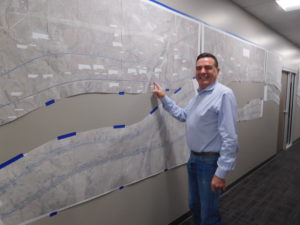He emphasized that rarely would there be traffic delays or stoppage while construction is underway.
Following several years of environmental and design studies, the Arizona Department of Transportation has approved a $446 million project to improve I-17 between Sunset Point on the north to Anthem Way traffic interchange on the south.
The 23-mile improvement project is expected to begin in April or May.
The contract has been awarded to Fann Contracting in Prescott and co-developer Kiewit Engineering Group Inc., one of North America’s largest engineering and construction organizations. The developer team will go by the acronym KFJV, for Kiewit-Fann Joint Venture team. Several other sub-contractors are also part of the contract.
The interstate to be improved is in mountainous terrain in Maricopa and Yavapai Counties.
I-17 is viewed as the primary connection between Flagstaff and Interstate 40 (I-40), which runs east and west in the north, and Interstate 10 (I-10) in Phoenix, which also runs east and west.
According to the Arizona Department of Transportation, the I-17 link between two of the nation’s principal east-west highways is critical because it carries well over a million travelers each year. It is the most important highway between the greater metropolitan Phoenix area and communities in Northern Arizona.
Fann Contracting Eager to Begin
Mike Fann, owner of Fann Contracting, in an exclusive interview from his Prescott office, told Flagstaff Business News that once begun, construction will be carried out simultaneously along all 23 miles of I-17.
He emphasized that rarely would there be traffic delays or stoppage while construction is underway.
“The only time we expect we will have any traffic delay at all because of construction is when we have to blast,” he said. “As soon as that action is taken and we have assurance that no safety issues are involved, traffic will be moving again.”
The project includes widening 15 miles of four-lane highway, replacing two bridges and one bridge deck, widening 10 bridges, and the creation of eight miles of what are being called “flex lanes.”
In cooperation with ADOT, it was determined the I-17 flex lanes will operate as separate two-lane roads that carry one direction of traffic at a time in either a north or south direction.
“The flow of traffic will be determined by what is the greatest need at the time along that winding eight miles of mountain driving between Black Canyon City and Sunset Point,” Fann said.
For example, flex lanes will be able to carry major northbound traffic on a Friday or Saturday, but on a Sunday, ADOT will be able to open the flex lanes to take southbound traffic to Phoenix.
‘’You need to know that the flex lanes will be next to, but separated with concrete barriers, from the southbound I-17 lanes. Access to flex lanes will be controlled by carefully monitored gates,” said Fann. “My company has the responsibility of monitoring those gates for three years after the construction is completed. Believe me, that is a responsibility we will take very seriously. Public safety is involved.”
The concept of flex lanes is fairly new, and is one that has been endorsed by ADOT.
Because so much traffic congestion occurs on weekends, the KFJV team is developing procedures to limit most lane delays for construction to weeknights from 7 p.m. to 6 a.m.
“Our work crews will be sensitive to when traffic is the heaviest. Even though we’ll be working along the entire 23 miles for the next three years, we’ll be scheduling our work so that traffic slowdowns or stoppages are minimal,” said Fann. “We’ll be especially alert to not having delays caused by day crews. We’ll also be sensitive to when weekend travel is the heaviest – during holidays and such events.”
During peak construction times, more than 500 people will be employed. “We are going to be adhering to a DBOM business model – Design, Build, Operate and Maintain. Part of my contract – and this is the biggest contract I’ve ever had – says that KFJV will remain responsible for maintaining the safe and functional operation of this stretch of I-17 for three years after the actual construction is done.”
FUNDS TO PAY FOR PROJECT
Funding sources for the improvement project come from a variety of sources. They include the following:
- $40 million from Arizona’s higher-
than-expected recovery revenue and Federal COVID-relief funds; - $130 million from state highway funds appropriated by the Arizona Legislature in 2019;
- $90 million from an Infrastructure for Rebuilding America grant;
- $50 million from the Maricopa Association of Governments as the Maricopa County portion of the project;
- $135.9 million from Federal and matching state highway funds, including $83.6 million approved by the Arizona State Transportation Board this past October.
For more information, visit azdot.gov. FBN
By Ray Newton, FBN







